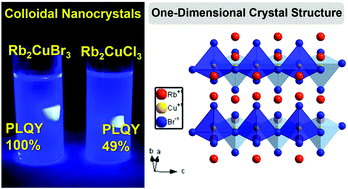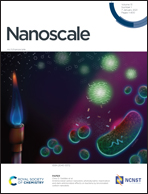Room temperature synthesis of low-dimensional rubidium copper halide colloidal nanocrystals with near unity photoluminescence quantum yield†
Abstract
Metal lead halide perovskite nanocrystals have emerged as promising candidates for optoelectronic applications. However, the inclusion of toxic lead is a major concern for the commercial viability of these materials. Herein, we introduce a new family of non-toxic reduced dimension Rb2CuX3 (X = Br, Cl) colloidal nanocrystals with one-dimensional crystal structure consisting [CuX4]3− ribbons isolated by Rb+ cations. These nanocrystals were synthesised using a room-temperature method under ambient conditions, which makes them cost effective and scalable. Phase purity quantification was confirmed by Rietveld refinement of powder X-ray diffraction and corroborated by 87Rb MAS NMR technique. Both samples also exhibited high thermal stability up to 500 °C, which is essential for optoelectronic applications. Rb2CuBr3 and Rb2CuCl3 display PL emission peaks at 387 nm and 400 nm with high PLQYs of ∼100% and ∼49%, respectively. Lastly, the first colloidal synthesis of quantum-confined rubidium copper halide-based nanocrystals opens up a new avenue to exploit their optical properties in lighting technology as well as water sterilisation and air purification.



 Please wait while we load your content...
Please wait while we load your content...